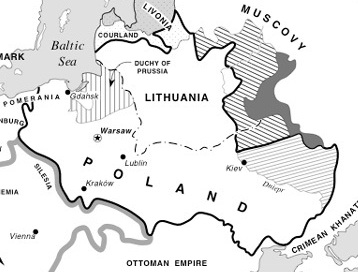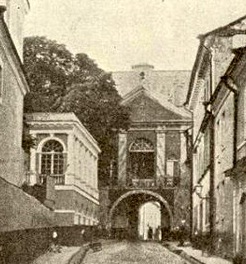 |
Recompiled by SCTJM
HISTORY OF OUR LADY OF OSTRABRAMA
The original of the holy image of Our Lady of Ostrabrama is housed in the chapel of the Dawn Gate of Vilnius, Lithuania.
The original painting is 163 x 200 cm and was painted by an unknown artist on 8 oak planks around 1630. It was covered with silver and gold around 1671. The head of Our Lady is adorned with two crowns. Two little angels lower the crown with colored glass inlays upon the smaller crown. The two crowns, made of pure gold, were blessed by Pope Pius XI in 1927. On July 2, 1927 a coronation ceremony took place and the painting received the title of Mother of Mercy.
The painting is an unusual portrayal of Mary since she is depicted without the infant Jesus.
The painting depicts the many facets of Mary. Her head is gently leaning to her right, her eyes are half closed, her hands are crossed in devotion. This reminds us that she is a virgin, humble servant of the Lord, merciful mother and patron of the people. At the same time, her head is surrounded by sun rays and her body is covered in elaborate gold and silver clothes and crowns. These are the symbols of her divine and majestic role as the Queen of Heaven.
The history of Our Lady of the Dawn, who is also known as Our Lady of Ostra Brama, begins in 1386. In that year prince Władysław Jagiełło (1351 – 1434) of Lithuania married the Polish princess Jadwiga. As part of the contact for marriage Jagiełło pledged the conversion of the Lithuanian people to Christianity. The marriage resulted in the joining of Poland and Lithuania into a Commonwealth of Nations. With the advent of Christianity, Marian devotions were introduced by princess Jadwiga.
The Polish-Lithuanian Commonwealth (or The Commonwealth of the Two Nations, Rzeczpospolita Oboja Narodów in Polish) was a federal monarchy-republic formed by the Kingdom of Poland and Grand Duchy of Lithuania and which was governed by an elected monarch.
Due to frequent attacks on the Lithuanian lands from the Tatars and regular conflicts with the Grand Duchy of Moscow, in 1503 Grand Duke Alexander of Lithuania granted the city of Vilnius a privilege to build fortifications of brick and stone around the entire city. The Gate of Dawn was built between 1503 and 1522 as a part of these defensive fortifications for the city of Vilnius. It has also been known as the Medininkai Gate, as it led to the village Medininkai south of Vilnius. In the Lithuanian language this gate was commonly known as ‘Auros Vartai’ (the gate of dawn). The Polish speaking population knew it as ‘Ostra Brama’ (the sharp gate).
Of the nine city gates, only the Gate of Dawn remains, while the others were destroyed.
Above each of the gates the people of the town placed an image of the Blessed Virgin. in the 16th century city gates often contained religious artifacts intended to guard the city from attacks and to bless travelers. About a century later, the Carmelite Order took over one of the parish churches in the vicinity of the southeastern gate of the town.
In 1655 the army of Moscow set fire to the city of Vilnius and most of the town was destroyed. The fire lasted seventeen days. However, the image above the Ostra Brama gate survived without any damage. This strongly encouraged the people’s devotion toward it and attracted many pilgrims. Since then it is considered a miraculous symbol of Lithuanian and Polish independence.
Between 1671 and 1761 seventeen more miracles attributed to the Lady in this image were chronicled. One story tells of a boy who fell from the second floor of a building and died. When his mother prayed before Our Lady of the Gate of Dawn he revived.
In 1702, when Swedes occupied Vilnius, it was forbidden to worship the icon publicly and to gather in the street. During the liberation fight of the gates, the icon of Our Lady was damaged by a shot. In 1711 the Chapel holding the image burned completely, but not before the miraculous painting was carried out of the fire by a young monk. For 20 years, the painting resided in the Church of St. Teresa. A new Chapel was subsequently built by the gate and the miraculous painting was reinstalled with great ceremony.
In 1799 Russian forces began to destroy the walls and gates of Vilnius. Inexplicably the Ostra Brama gate was left untouched.
In 1829, the chapel took on the style of the late Classicism. The chapel was built so that the faithful could pray in front of it in the street, because the entrance to the chapel was from the monastery's garden, and lay people, especially women, were not allowed to enter there. During the reconstruction work in 1828-1829, the side windows were enlarged to reach the floor level.
The chapel was renovated in 1931-1932. During the Second World War and the Nazi German occupation of Lithuania the Archbishop of Vilnius decided that the miraculous picture should stay in the town. During the Russian communist occupation of Lithuania the chapel of Ostra Brama remained open.
On September 4, 1993 Pope John Paul II said Rosary at the Gate of Dawn Chapel.
From St Faustina Maria Kowalska’s Diary
“O Mary, my Mother and my Lady, I offer you my soul, my body, my life and my death, and all that will follow it. I place everything in your hands. O my Mother, cover my soul with your virginal mantle and grant me the grace of purity of heart, soul and body. Defend me with your power against all enemies, and especially against those who hide their malice behind the mask of virtue (79). Fortify my soul that pain will not break it. Mother of grace, teach me to live by God’s power (315).” “O Mary … a terrible sword has pierced your holy soul. Except for God, no one knows of your suffering. Your soul does not break; it is brave, because it is with Jesus. Sweet Mother, unite my soul to Jesus, because it is only then that I will be able to endure all trials and tribulations, and only in union with Jesus will my little sacrifices be pleasing to God. Sweetest Mother, continue to teach me about the interior life. May the sword of suffering never break me. O pure Virgin, pour courage into my heart and guard it (915).”
Sources:
St. Mary Of Ostrabrama Roman Catholic Church


